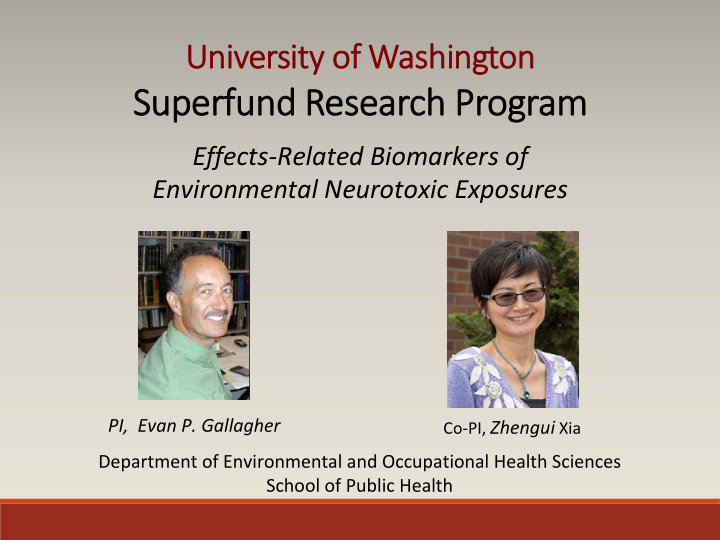



Univer Univ ersity o sity of W f Washing ashington n Supe Superfund rfund Rese sear arch h Pr Progr gram am Effects-Related Biomarkers of Environmental Neurotoxic Exposures PI, Evan P. Gallagher Co-PI, Zhengui Xia Department of Environmental and Occupational Health Sciences School of Public Health
WEBSITE
Conceptual model : UW Superfund research program
Our Resear Ou esearch ch Pr Projects ojects Mechanisms and Biomarkers of Metal Olfactory Injury in Salmon PI, Evan Gallagher, PhD. (collaborators, Zia, Storm) Cellular and Molecular Mechanisms of Cadmium Neurotoxicity PI, Zhengui Xia, PhD. (collaborators Gallagher, Storm) R ole of Paraoxonases in Modulating Cadmium and Manganese Neurotoxicity PI, Clement Furlong, PhD. Co-PI-Lucio Costa Arsenic in Shallow, Un-stratified and Seasonally Stratified Urban Lakes: Mobility, Bioaccumulation and Ecological Toxicity PI, Rebecca Neumann, PhD. (collaborators Gawel, Olden, Horner-Devine, Gallagher)
UW SRP Suppo UW SRP Support Co rt Cores es Functional Genomics and Bioinformatics Core Director, Theo Bammler, Ph.D. Research Translation and Community Engagement Cores Director, Tom Burbacher (L. Hayward, Ph.D., Communications manager) Ad Administrative and Training Cores Director, Evan Gallagher, Ph.D. (E. Guzy, Program Manager)
UW SRP investigators
Project 1-Mechanisms of olfactory injury: Effect of environmental levels of Cd on salmon neurobehavior Effect of Cd on time spent in con-specific odorant arm of a Y-maize 100 90 80 % time in odorant arm 70 60 50 * * 40 30 * 0 ppb 20 0.3 ppb 3 ppb 10 2 ppb 0 Pre exp. 16 d exp. Depuration of 16 d Toxicological Sciences 2016
LA-ICP-MS shows that Cd rapidly accumulates and persists in the salmon olfactory epithelium 8 7 Cadmium Conc. (ppm) 6 5 4 3 2 1 mt1a < LOQ <LOQ <LOQ <LOQ 0 8 16day Cd exposures Fold change relative to control Depuration *** 7 6 5 *** 4 * 3 2 1 0 0.3 2 0.3 2 Cd exposure levels (ppb)
Regeneration of the olfactory system after Cu Project 1. Copper injury to zebrafish OSNs is dose-dependent and targets both ciliated and microvillous OSNs OMP:RFP TRPC2:V enus Eva Ma
Regeneration of the olfactory system after Cu Project 1 . Using zebrafish transgenics we see that olfactory cell proliferation increases after injury from Copper and leads to recovery of olfaction OMP:RFP TRPC2:V enus 0 uM (6 dpf) 10 uM Cu 24 h (6 dpf) 10 uM Cu for 24 h and 24 hr recovery (7 dpf) BrdU labeling in OMP-RFP transgenics Dr. Eva Ma
ASARCO smelter, Ruston, WA 1890–1986 Gawel et al., 2014 surface sediment max depth seasonal Study lake (mg As/kg) (m) stratification Angle Lake 208 5.8 yes Lake Killarney 206 4.5 weak/no North Lake 85 9.0 yes Steel Lake 48 7.6 weak/no
Specific Aims for Project 4 1. Identify physical and biogeochemical lake attributes that promote arsenic mobilization from sediments and maintain elevated aqueous concentrations of arsenic in unstratified oxic lakes 2. Determine the physical and biogeochemical factors that control arsenic bioaccumulation through aquatic food webs in both seasonally stratified and unstratified lakes. trout 3. Assess ecological toxicity of arsenic at different omnivorous in sects trophic levels within both seasonally stratified and zoop lankton unstratified lakes using established and novel molecular biomarkers that indicate arsenic stress foraging macrophytes phytoplankton & periphyton insects and injury.
Research Translation Core Lisa Hayward (Manager) SRP RTC and NIEHS Center (EDGE) CEC Ph.D. in Environmental Endocrinology Post-Doctoral work in Conservation Biology Science and Technology Policy Fellowship with AAAS Managed Communications for the Department of Interior ’ s Northwest Climate Science Center
CREATING INDIVIDUALIZED RESEARCH TRANSLATION PLANS FOR EACH PROJECT AAAS Public Engagement Plan Template Goals, near-term, mid-term, long-term • Information sheets for Policy Makers • Continuing Education Classes for Medical Practitioners • Engagement with Local Regulatory Agencies and Lake Association Members • Presentations for Groups such as National Parkinson ’ s Foundation and Partner ’ s in Parkinson ’ s http://theconnector.missouri.edu/wp-content/uploads/2018/04/TEMPLATE-PE-Plan-Template.pdf
Research Translation Core (RTC) RTC Material E-Bulletin Tweets To-the-Point Fact Sheets
Research Translation Core (RTC) RTC Engagement Continuing Education Lower Duwamish Boat Tours Pub Talk
Educating Next Generation of Community Leaders CAMPUS VISIT FOR BRIDGE (CDC) and SURE-EH (NSF) STUDENTS Duwamish Valley Youth Corps Conduct tours of SRP labs with Career Day investigators and trainees Meet with Office Minority Affairs –Education Ambassadors
Community Engagement Core (CEC) Goal The primary goal of the CEC is to work with community stakeholders and federal, state and local agencies to develop intervention strategies to reduce community exposures to hazardous substances in order to improve public health
Specific Aim 1 Work with community organizations and federal, state and local agencies to develop intervention strategies to reduce exposure to fish contaminants at the Lower Duwamish Waterway (LDW) Superfund Site in Western Washington. Community Health Advocates Katie Frevert, CEC Manager Institutional Controls meeting with Fish & Wildlife at Duwamish River Festival Fish Advisories staff
Community Advocates for Safe Fishing Collaborating with nonprofit organization Just Health Action led by Linn Gould, MPH FishNet webinar, Using a Community-Based Process to Promote Healthy Fish Consumption within the Lower Duwamish Waterway Superfund Site. https://www.youtube.com/watch?v=NDmkoBJpKYU
Simplifying Fishing Rules and Regulations Working with Washington State Department of Fish and Wildlife English Spanish Vietnamese Maps with fishing locations and regulations
Simplifying Fishing Rules and Regulations Short Educational Videos on Fishing Rules & Health The themes for these Educational Videos include: 1. Opportunities Available to Fishers in the Duwamish 2. What Do I Need to Know Before Going Out? (Rules/ Regs/Safety/Fish Types) 3. How to Buy a Fishing License 4. What Fishing Gear Do I Need? 5. How to Land a Fish & Clean it Properly 6. Cooking Fish and Health Tips
Community Engagement Core (CEC) Specific Aim 2 Build upon our previous collaborations with the Northwest Toxic Communities Coalition (NWTCC) to address hazardous waste site issues common across neighborhoods and reduce exposures to contaminants in these waste site communities.
NWTCC Collaborations Quarterly Webinars
Needs Assessment Outcomes • Grant Writing Assistance • Environmental Sampling
Recommend
More recommend